S Navy
-
- NAVY WORK IN PRIVATE U.S. YARDS Maritime Reporter, Aug 15, 1984 #20
With the virtual disappearance of the market for oceangoing merchant ships, most of the major private yards in the U.S. are heavily dependent upon Navy shipbuilding, conversion, and repair for the majority of their work, some as much as 100 percent. The contracts placed by the Navy during the past few years, including the several programs for the Military Sealift Command, have meant survival for some yards that otherwise may have been forced to cease operation.
The MR/EN editors asked the private U.S. shipyards that are engaged in Navy work to tell us about their current activities and their outlook for the next few years.
The review that follows is based on the replies that we had received up to press time.
FOR MORE INFORMATION If you wish to receive additional data on any of the shipyards included in this review, please circle the appropriate number(s) that follows each yard description, on the Reader Service Card in the back of this issue. If you wish to receive information on all of the companies included in this review, Circle 10 on Reader Service Card AVONDALE Avondale Shipyards, Inc., a short distance up the Mississippi River from New Orleans, has historically targeted half of its new construction capacity to the building of naval ships and half to merchant vessels. The last merchant ship left the yard in July this year, and the balance has tilted to 90 percent navy work and a decreasing 10 percent of commercial work. The total reliance upon naval shipbuilding is expected to continue, and Avondale has adapted its design, management, and shipbuilding trade disciplines and skills accordingly.
The yard is currently converting three SL-7 containerships to Navy Fast Sealift Ships (T-AKR) and has delivered the first vessel. Delivery of the second of these rapid deployment vessels is scheduled for late 1985, and the third in early 1986. The design for these extensive conversions—adding decks, RO/RO capability, cranes, and other systems for self-contained loading and unloading—was performed in-house by Avondale.
The construction of the first of a new class (T-AO-187) of fleet oilers has begun, and construction of the second ship will start shortly. Follow- on ships will be constructed at about six-month intervals. This design was also performed in-house.
Additional T-AO-187 class ships will be bid as funded for up to a total of seven ships in Fiscal Years 85, 86, and 87.
The engineering for the landing ship dock LSD-44 is proceeding in preparation for construction, with keel laying scheduled for March 1985. Avondale has options for two additional LSDs in FY 85 and two in FY 86. Competition for a FY 87 variant of the LSD-41 class is anticipated.
In addition, Avondale is constructing the forebodies for five 30,000-dwt T-5 tankers for Tampa Ship that will be chartered by Ocean Carriers, Inc. to the Military Sealift Command. Delivery of the first forebody is scheduled for September this year, with the other four following at three-month intervals.
Circle 11 on Reader Service Card BATH I R O N WORKS Bath Iron Works (BIW) in Maine is celebrating its 100th anniversary in 1984 and, like some other American shipyards, found itself in a key period of transition. BIW passed the century mark facing a phase-out of the Navy guided-missile frigate program, and bleak prospects for any new commercial ship construction contracts in the near future.
Since BIW built the lead ship of the FFG-7 class in the mid-1970s, it has received contracts for 23 follow- on ships. This steady flow of work enabled the yard's work force to swell to 8,400 in the fall of 1982, then level off to some 7,000 workers. However, BIW has only one more keel to lay in the FFG program, and the last ship of this class will be delivered to the Navy in 1986.
The situation has caused BIW management to term the summer of 1984 as one of the key periods in the shipyard's long and storied history. That assessment was given because BIW faced head-to-head with Ingalls Shipbuilding for three additional Aegis cruisers, with options for three additional vessels.
BIW was also anticipating an opportunity to bid, along with several other yards, to become the lead yard designer and builder of the new Aegis destroyer. Prior to the summer of 84, the Maine yard had received contracts for only two of the Aegis cruisers, and saw a need to secure a significant number of this CG-47 class vessels in order to take up the slack that would be resulting from the phaseout of the FFG program.
As of July this year, BIW had six FFGs in various stages of construction.
It also had contracts for two Aegis cruisers—CG-51 and CG-58. The keel laying for CG-51 is scheduled for August 31 to coincide with the shipyard's centennial launching of the Simpson (FFG-56), a guided-missile frigate.
Circle 12 on Reader Service Card BIW-PORTLAND Bath Iron Works' new ship repair facility in Portland, Maine, became operational in December 1983, and a three-ship overhaul package for three destroyers of the DD-963 class had been scheduled into that facility, which is equipped with an 80,000-ton-capacity drydock.
The USS Conolly arrived February 15 and is slated to depart in mid-December. The USS O'Bannon arrived in early August, to be followed by the USS Deyo in February of 1985. Additionally, BIW re- cently received an $ll.l-million contract to overhaul the USS Page; that work is slated to begin at the Bath yard in September this year.
The Bath yard is also continuing to perform post shakedown availability work on a number of its FFGs, as well as a few built by Todd Shipyards.
The mix of work had maintained a total work force for both the Bath and Portland yards of some 7,000 at midyear, but BIW officials continue to cast a cautious eye toward the future.
Circle 29 on Reader Service Card BETHLEHEM STEEL The Marine Construction Group of Bethlehem Steel Corporation is currently reconstructing five vessels for the U.S. Navy's new Maritime Prepositioning Ship Program (T-AKX). Three of the ships are being converted at the Sparrows Point yard near Baltimore, and the other two at the Beaumont, Texas, facility. Total value of the contracts for the five vessels is more than $600 million.
The first T-AKX ship to be delivered is the Cpl. Louis J. Hauge Jr., formerly the Estelle Maersk, which was reconstructed at Sparrows Point. That vessel was delivered in July of this year, one month ahead of schedule. The ship's name became official on July 14 when Mrs. Catherine Braunschweig of Kent, Wash., sister of the World War II Medal of Honor winner for whom the vessel is named, performed the christening ceremony.
The Estelle Maersk, along with the four other Maersk RO/RO vessels, was selected in 1982 to be reconstructed by Bethlehem Steel because, with her redesign, she would be well suited to the prepositioning ship mission. Each ship will be used for the mobile, longterm storage of vehicles, helicopters, weapons, ammunition, fuel, and other material to supply a Marine Corps Amphibious Brigade.
To meet these mission requirements, Bethlehem separated the vessel amidships, added a 157-footlong midsection that extended her length to 755 feet. Her depth was changed with the addition of two new dock levels, increasing the keel-to-dock depth by nearly 16 feet, from 54 to 70 feet. This required the alteration of three decks—first, main, and upper.
These expansions provided more cargo hold, space for a third set of twin 36-ton-capacity cranes, and an additional 80-person deckhouse for "surge" crews during periodic loading and unloading. The normal crew complement will be about 65. Other major additions included new ramps, fuel tanks, repair shops, and an aft helicopter landing platform.
Circle 14 on Reader Service Card COASTAL DRY DOCK Coastal Dry Dock & Repair Corporation, located in New York at the former Brooklyn Naval Shipyard, is currently overhauling two U.S. Navy ships—the frigate USS Pharris (FF-1094) and the destroyer USS Nicholson (DD-982).
In addition to these two combatants, the yard is working on the Military Sealift Command's stores ship USNS Rigel (T-AF-58).
Within the past year Coastal has completed the regular overhaul of two frigates and one destroyer.
These overhauls have included extensive electronics/ ordinance upgrades and considerable machinery work.
The Brooklyn yard is expecting the USS Thorn (DD-988) in February 1985, which will complete the three-destroyer overhaul contract awarded in April 1983.
Coastal Dry Dock has established a reputation for the efficient overhaul of Naval combatants, and is currently soliciting additional Navy work. With the arrival of the Surface Action Group in the late 1980s, the yard is looking forward to working with the Port of New York and the Navy to bring additional employment to the area.
Circle 2 8 on Reader Service Card GENERAL DYNAMICS The General Dynamics Electric Boat Division in Groton, Conn., is the nation's only shipyard dedicated solely to the design, construction, and support of nuclearpowered submarines for the U.S.
Navy. The yard builds two classes of submarines—Ohio Class missile- firing Tridents and Los Angeles Class (SSN-688) fast attack boats.
Solid construction performance during the first half of 1984 has culminated in ahead-of-schedule delivery of two attack subs, the Minneapolis-St. Paul (SSN-708) and the Hyman G. Rickover (SSN- 709), and one Trident, the Georgia (SSBN-729), making a total of eight consecutive submarines delivered ahead of schedule. This performance reflects the Division's commitment to innovative construction and engineering techniques such as modular construction and computer-aided design/ computer aided manufacturing (CAD/CAM), which have improved productivity and reduced construction times.
Submarine hull cylinders are produced in an automated welding facility at Quonset, R.I., where they are end-loaded with foundations, decks, wiring, piping, and large components. The completed cylinders are then joined to form complete hulls at the land-level submarine construction facility at Groton.
Recently, the Quonset Point facility has taken on even more submarine fabrication work. A$9-million waterfront improvement project that began full operation early this year has doubled the capacity, to 600 tons. Three basic components comprise the system: a 700-ton-capacity, multi-wheeled ground transporter; a new 195-foot barge with jackup legs; and underwater concrete pads at both plants to receive the legs for docking.
At present, Electric Boat has 16 ships under construction—seven Tridents and nine SSN-688s.
Among the Tridents, the Henry M.
Jackson (SSBN-730) is undergoing sea trials prior to a scheduled delivery this fall; the Alabama (SSBN-731) was launched in May this year and will be delivered in the spring of 1985; and SSBN-732- 736 are in various earlier stages of construction. (General Dynamics recently received a Navy contract to accelerate fitting the ships with even longer range Trident II missiles).
Among the ships in the yard's attack submarine program, the Augusta (SSN-710 is being prepared for sea trials; the Providence (SSN-719) was launched on August 4 this year and is scheduled to be delivered in the spring of 1985; and the remaining seven ships are in various earlier stages of construction. Of special significance are SSN-791 and SSN-720, first in their class to feature the Tomahawk cruise missile vertical launch capability.
The U.S. Navy has authorized Electric Boat to accomplish preliminary design work on a new class of attack submarine that is planned to counter the growing threat posed by advanced Soviet submarine designs. This design work was completed in June this year, and it is expected that the Navy will shortly initiate the next phase of competition, which will ultimately be geared toward selecting a contractor to serve as design agent for this all-new submarine.
The Quincy Shipbuilding Division of General Dynamics in Massachusetts is participating in the Navy's Maritime Prepositioning Ship (T-AKX) program under a $775-million contract for the construction of five ships.
The only newly built vessels in the T-AKX program, the 645-foot ships will displace 40,800 tons fully loaded, and be powered by Stork-Werkspoor diesel engines with a total output of 26,000 bhp.
Each of these ships will be capable of carrying 25 percent of the equipment needed to support a Marine Corps brigade. In addition, each will carry 1.6 million gallons of petroleum products in bulk and 81,000 gallons of potable water.
The Quincy yard has laid the keels for the first two ships, and 2nd Lt. John P. Bobo and the Pfc.
Dewayne T. Williams. All of the MPS vessels will be named for servicemen who earned the Medal of Honor.
Circle 15 on Reader Service Card INGALLS SHIPBUILDING On July 4 this year the U.S.
Navy placed in commission a second Aegis guided-missile cruiser, the USS Yorktown (CG-48). The new ship is one of 11 contracted by the Navy to Ingalls Shipbuilding division of Litton in Pascagoula, Miss. Ingalls delivered the lead ship, USS Ticonderoga (CG-47) ahead of schedule in 1982, and that ship has now completed a highly successful first deployment to the eastern Mediterranean.
Yorktown was also delivered ahead of schedule, and has reported for duty with the Atlantic Fleet.
Nine additional Aegis cruisers are under construction or in planning at Ingalls including the Vincennes (CG-49), which will be commissioned in July 1985, and Valley Forge (CG-50), which will be christened September 29 this year. These ships will bring to the Navy the same high quality workmanship as exemplified by the outstanding performance of the first two Aegis cruisers to join the Fleet.
Ingalls is also building the lead ship in a new class of multi-purpose amphibious assault ships, the Wasp (LHD-1). Similar in many respects to five Tarawa (LHA-1) Class assault ships built by Ingalls in the 1970s, this new class will significantly improve and revitalize the Navy/Marine Corps team's sealift capability. Designed to accommodate the Navy's new LCAC air cushion landing craft and Harrier jet aircraft, LHD-1 will have as a primary mission the embarkation, deployment, landing, and support of a Marine landing force.
At 844 feet long with a beam of 106 feet, the 40,500-ton Wasp will be the third largest ship type in the U.S. Fleet. The lead ship of the new class is scheduled for delivery in early 1989.
In April this year Ingalls completed a complex modernization and reactivation work package aboard the battleship Iowa (BB- 61), and redelivered the ship ahead of a schedule that was twice accelerated by the Navy. Ingalls' job was to bring this great ship into the missile era with modern weapons and electronics, including Tomahawk and Harpoon cruise missiles and Phalanx rapid-fire guns.
Living quarters for her 1,500 officers and crewmen were updated, and her engines and boilers were overhauled and modernized to burn the Navy's standard distillate fuel.
Her nine 16-inch guns were refurbished, as were 12 five-inch guns.
Modern communications, air and surface search radar, and electronic countermeasures systems were installed as well. USS Iowa was recommissioned on April 28 this year and has reported for duty with the Atlantic Fleet.
Ingalls is also continuing to build on a well-deserved reputation in the overhaul of surface ships. The yard has completed overhauls of six Spruance (DD-963) Class destroyers an average of four weeks ahead of schedule, and all within budget. Two additional overhauls are under way, the Spruance ships USS John Rodgers (DD-983) and USS Moosbrugger (DD-980). These ships will rejoin the Fleet in May and August 1985, respectively.
Leading the industry in the development and application of computer technology for ship design and construction, Ingalls maintains a 1,500-member engineering and design staff, which includes an ongoing independent R&D program.
This engineering staff has assisted the Navy in the design of its next destroyer class, the Arleigh Burke (DDG-51) Class of Aegis destroyers. This new ship represents an important aspect of Ingalls' future shipbuilding activity.
Circle 16 on Reader Service Card LOCKHEED SHIPBUILDING Lockheed Shipbuilding Company (LSC) of Seattle (formerly Lockheed Shipbuilding & Construction), a wholly owned subsidiary of Lockheed Corporation of Burbank, Calif., presently has $1 billion of new shipbuilding construction work under way for the U.S. Navy. The yard is building three dock landing ships (LSD) that were designed by Lockheed.
These ships are 609 feet long overall, with an 84-foot beam and 20- foot fully loaded draft.
The LSDs are amphibious assault ships designed to carry U.S.
Marine Corps troops, their equipment, and their supplies to points around the world. The assault ships will lay to "over the horizon" and will carry four 87-foot by 50-foot air cushion landing craft (LCAC) in their floodable wet wells. (Note: the LCACs currently under construction for the Navy are being built by Bell Aerospace-Textron in New Orleans).
The three LSDs under construction at LSC are: the Whidbey Island (LSD-41), approximately 95 percent complete and scheduled for delivery in November this year, built at a contract cost of $338.6 million; the Germ an town (LSD-42), approximately 80 percent complete, with a delivery date of October 1985 and contract cost of $304 million; and the yet unnamed LSD-43, approximately 22 percent complete and scheduled for delivery in June of 1987, contract cost $271.
On June 29 this year Navy Sec- retary John F. Lehman Jr. announced that Lockheed Shipbuilding had won one of the two design and production feasibility contracts for production planning of additional LCACs for second-source procurement. Congress had directed the Naval Sea Systems Command to secure a second source (other than Bell Aerospace-Textron) to build this class of craft.
The construction contract will be announced in April 1985.
Circle 17 on Reader Service Card MARINETTE MARINE Marinette Marine Corporation (MMC) in Northern Wisconsin is in its 28th year as a builder of defense- related marine equipment, and is well known for its versatility in the design and construction of Navy ships and craft of all types.
MMC, under contract to the Naval Sea Systems Command, is producing a new generation of Mine Countermeasure (MCM) vessels in its 70,000-square-foot MCM ship erection building, which was specifically designed and constructed to accommodate the construction of these vessels. This new facility enables MMC to build, in an environmentally controlled area, two MCMs simultaneously.
The keel was laid for the second vessel of this class, the Champion (MCM-4) in June this year, while construction of the first, the Defender (MCM-2), is well under way. The 224-foot laminated wood hull, sheathed in glass-reinforced plastic, represents one of the most sophisticated and capable mine countermeasure ship classes ever built in the U.S. or the world.
Under another Navy contract, MCM has completed and submitted its Minesweeper Hunter (MSH) contract design for evaluation, and looks forward to contract award for lead ship construction later this year. The company's MSH design proposes the hull and superstructure to be constructed of monocoque glass-reinforced plastic, which is advantageous to the mission requirements of this vessel.
The MSH is capable of conducting operations against surface and subsurface targets, either independently or as a part of a larger force to support the naval and coastline defense of the U.S.
Delivery of the first of eight Torpedo Weapon Retrievers (TWR) will begin in October this year, with final delivery in September of 1985. The Navy awarded a contract for five TWRs to MMC in July 1983, and a three-vessel option was exercised in October. The 120-foot, 2,000-bhp steel vessel, a totally new design developed by MMC, is capable of staying on station for one week recovering spent missiles and torpedoes fired during weapons system tests on Naval combatant submarines and surface ships.
In February this year, Marinette was awarded a contract by NAVSEA for the construction of twenty-eight 50-foot, steel-hull workboats, with an option for 24 additional vessels. Delivery of the workboats to both the East and West Coasts will be two per month starting later this year. In previous years, MMC has been awarded contracts by the Navy for more than 50 of this type craft.
Circle 18 on Reader Service Card NATIONAL STEEL Navy work at National Steel and Shipbuilding Company (NASSCO) in San Diego is progressing on schedule toward completion of two major contracts: the conversion of three Waterman RO/RO vessels into T-AKX Maritime Prepositioning Ships to be timechartered to the Military Sealift Command; and the conversion of three SL-7 former Sea-Land containerships to T-AKR Rapid Deployment Ships, also for the MSC.
Conversion of the RO/RO ships has involved the construction of 126-foot midbodies to provide additional cargo capacity. The overall length of the converted ships will be 821 feet. The original deckhouses are being modified to in- crease personnel accommodations from 41 to 183. Two twin pedestal cranes are being installed on each ship's main deck to handle offloading of cargo, including amphibious landing support craft.
When converted these ships will provide the capacity to rapidly transport to any desired location 25 percent of the vehicles and initial supply of ammunition, fuel, and rations for a Marine Corps amphibious brigade.
NASSCO has been involved with the T-AKR program since its inception in the fall of 1981, when the Navy surveyed the industry to determine which shipyards would be interested and could qualify for design and conversion of these ships. Subsequent to its successful performance during the competition/ design phases, NASSCO was in September 1982 awarded a contract to provide the detail design and conversion work for two ships with an option for a third. The option for the third ship has been exercised.
The T-AKR ships will be stationed in the U.S. and, if an emergency arises, will be loaded with military cargo to provide rapid second-wave support to deployed combat troops. These 946-foot ships have speed of up to 33 knots. Conversion will include removal and rebuilding of internal structures used in carrying containers, as well as installation of new internal and external ramps for loading, storing, and unloading military vehicles. Additional decks, cargo cranes, and a helicopter hangar are also being added.
NASSCO is awaiting arrival in September this year of the 87,000- dwt NASSCO-built tanker Worth, which will be converted into a TAH hospital ship. This is the first of a two-ship contract worth a total of $336.2 million. The second T-AH conversion will be the 87,000- dwt tanker Rose City, also built by the San Diego shipyard.
Circle 19 on Reader Service Card NEWPORT NEWS Newport News Shipbuilding (NNS) in Virginia, the country's largest privately owned shipyard, has designed, built, overhauled, and repaired a wide variety of ships for the U.S. Navy. Today it is the only yard in the U.S. capable of building and servicing a full range of surface and submersible vessels.
NNS currently has 10 Navy ships under construction or contract— three aircraft carriers and seven high-speed attack submarines.
The 688 Class submarine Chicago (SSN-625) will be launched on October 13 this year, the 209th birthday of the U.S. Navy. The carrier Theodore Roosevelt (CVN- 71) will be launched on October 27, the birthday of the president for whom she is named and Navy Day.
Newport News is also overhaul overhauling and refueling five submarines, and has contracts to plan for similar work on two additional subs.
The yard recently completed the overhaul of the aircraft carrier Nimitz (CVN-68) and returned her to the fleet in a period of 13 months.
A leader in application of high technology to shipbuilding, Newport News Shipbuilding provides a variety of engineering services to the Navy. It has been awarded several contracts to modify and improve existing ship designs, and to develop designs for new classes of submarines and surface ships.
The yard currently employs some 29,000 people, many of whom are fourth generation shipbuilders.
Circle 20 on Reader Service Card NORSHIPCO A Phased Maintenance contract with the U.S. Navy's Naval Sea Systems Command has provided the Norshipco yard in Norfolk with repair work for three T-AO-177 class oilers over a 54-month period.
The three ships that will undergo repairs—the USS Merrimack, USS Monongahela, and USS Platte—will require a total of eight major repairs. Work on the Merrimack is scheduled to be completed by August 31 this year, and the Monongahela will arrive at the yard September 3.
Norshipco has also been responding to Selected Repair Availability (SRA) work of 60- and 90- day durations. Of the many Navy ships repaired by the Norfolk yard on this basis, recent contracts have been obtained on two such vessels— the USS Kidd that departed the yard recently, and the USS Caron that is scheduled to arrive August 21.
In addition, Norshipco is benefiting from the significant level of repair work being done at Naval Base-Norfolk and Amphibious Base-Little Creek, Va. The yard is providing support in this area on a contract basis. Work was also completed recently on the USS Newport and the USS Sustain.
Circle 21 on Reader Service Card PENNSYLVANIA SHIPBUILDING In common with most other major U.S. shipyards, Pennsylvania Shipbuilding Company's current workload is heavily dependent on work for the U.S. Navy, a condition that is expected to continue for some time.
The principal activity in the yard at Chester, Pa., is the conversion of the USNS Denebola (TAKR- 289) from an SL-7 cellular containership (ex Sea-Land Resource) to a fast supply ship. This is the second such ship to be converted at Penn Ship; the first, USNS Capella (T-AKR-293), was delivered to the Navy in June this year. Work on the Denebola has just started, with delivery scheduled for October 1985. During that period, this $60-million contract is providing an average of about 500 jobs.
In addition to work on the Denebola, the Chester yard is actively supporting the Philadelphia Naval Shipyard on a number of programs, most notably the Ship Life Extension Program (SLEP) of the aircraft carrier USS Forrestal (CVA-59).
Penn Ship recently submitted a proposal for the Phased Maintenance Program of the USS Patterson (FF-1061), the first of four Naval Reserve Force frigates to be based in Philadelphia. This program, which involves four overhauls plus around-the-clock repair, maintenance, and spare parts service over the next five years, is expected to be awarded shortly to a contractor in the Philadelphia area.
Circle 22 on Reader Service Card PETERSON BUILDERS Peterson Builders, Inc. (PBI) of Sturgeon Bay, Wise., is well known as the Great Lakes shipyard that has always maintained its reputation for quality, diversification, and ingenuity. Contracts won for the 14 vessels now under construction for the U.S. Navy are testimony to PBI's experience and com- petitive edge. Keels have been laid for 10 of these vessels, and since November 1983 five have been launched.
Wood construction, a special area of expertise at PBI, is the material being used for the Mine Countermeasures Ships (MCM) and patrol boats (YP). Peterson is the only Navy-approved shipyard in the U.S. with the capabilities and experience to perform certified wood lamination work. The Navy contract for the rugged Salvage Ships (ARS) calls for steel construction.
PBI's development plans have resulted in an outstanding solution for current world needs in multi-mission patrol craft—the 66- foot PBI MK-1 that the yard is now marketing. This aluminum inshore patrol boat is capable of a speed of more than 38 knots, and can be tailored to meet a wide range of simultaneous operational missions at affordable prices.
The 224-foot MCMs represent a new concept in defensive mine warfare, combining the functions of both the conventional minesweeper and the more recent design of the mine hunter. As the lead yard for this proposed 14-ship Navy program, PBI has contracts for three MCMs and is working closely with the Navy in the design and development of the series, as well as providing drawings, purchasing, planning, scheduling information, and other data to the follow-on yard.
The four 225-foot ARS auxiliary rescue/salvage vessels also represent a new class of ships that PBI is building for the Navy. These Safeguard ARS-50 Class ships will replace the Navy's aged and diminished rescue/salvage vessels.
Mission duties of the ARS are to provide salvage, towing, and firefighting services at advanced bases and U.S. ports. The ships are also capable of lifting submerged objects as well as extensive diving support operations. They will possess the finest diver life support air system in the Navy. The salvage holds of the ship are fitted with portable equipment to effect assistance to other vessels in dewatering, patching, and providing electrical power and other essential services required to return a disabled ship to operating condition.
The 108-foot YP yard patrol craft is an expanded and refined version of the highly successful 80-foot YPs built by PBI for the Navy in the recent past. These seven new vessels will be equipped to provide trainees at the U.S. Naval Academy at Annapolis with "hands-on" experience in ship maneuvering, communications, and navigation.
Circle 23 on Reader Service Card SOUTHWEST MARINE Southwest Marine Inc. (SWM), San Pedro Division, currently has several U.S. Navy contracts in progress. Major repair work is being accomplished on the destroyer USS Ingersoll (DD-990).
During drydocking of this ship, repairs are being made to the sonar dome and the starboard controllable- pitch propeller. The scope of the work includes replacement of all blades, hub, and the OD box, along with flushing and cleaning of all internal piping of the starboard propulsion system. Work being performed on the sonar dome includes determination of the extent of damage, repair of any damage found, and the resurfacing and repairing of the internal and external dome structure.
Aboard the amphibious assault ship USS Peleliu, SWM is in the process of converting a compartment into a computer operations area. This alteration entails the removal of existing structures within the compartment and the installation of new alterations as required. The yard is also installing new foundation and bulkhead structures to accommodate the installation of computer components and associated hardware.
In conjunction with SWM of San Francisco, the San Pedro Division is in the final phase of structural modifications to the winch decks of the replenishment oiler USS Wichita (AOR-1). San Pedro's work included construction of new winch deck platforms, which consisted of layout, surface preparation, coating, preassembly, final assembly, and installation aboard the ship.
SWM of San Francisco has a 2,800-ton drydock that is 389 feet long, 84 feet wide, and can dock ships with drafts up to 16 feet.
Presently in the drydock is a Navy oceangoing tug that is undergoing a complete overhaul of her Fairbanks- Morse diesel engine. The vessel's hull and superstructure is being blasted to bare metal from the keel to the top of the wheelhouse.
The preservation system being applied by SWM's crew is inspected daily by quality assurance inspectors to insure high-quality workmanship. General repairs to the tug's shafts, propellers, and electronics are also being accomplished during the drydocking period.
Southwest Marine's San Diego yard currently is performing repairs and hull preservation on the Navy's auxiliary repair dock USS San Onofre (ARD-30). This contract is valued at $2 million; repairs are expected to take 50 days.
The destroyer USS David R.
Day (DD-971) entered the San Diego yard in July for an eightweek restricted availability. The repairs and modifications affect the vessel's machinery and power distribution systems.
Circle 24 on Reader Service Card TACOMA BOAT Tacoma Boatbuilding Company in Washington is constructing 12 ocean surveillance vessels—224- foot ships that will tow sophisticated acoustical listening devices at slow speeds and at various depths throughout the world's oceans.
The USNS Stalwart (T-AGOS-1) was launched in July 1983 and delivered to the Navy in the spring of 1984. USNS Contender (TAGOS- 2) was launched in December 1983, and USNS Vindicator (T-AGOS-3) was launched in June this year.
After delivery of Vindicator in late September, the classified acoustical equipment, termed Surveillance Towed Array Sensor (SURTASS), will be installed aboard the vessel at the Military Sealift Command's West Coast base in Oakland, Calif., by the Navy's Electronic Systems Command.
The fourth T-AGOS is now under construction and scheduled for launching in September. The remainder of the ships of this class will be launched and completed at intervals of approximately three months, with the last of the 12 ships in the program to be launched in October 1986.
Propulsion for the T-AGOS is provided by a diesel-electric system, comprising four Caterpillar/ Kato 600-kw diesel generators driving two General Electric 1,600- hp dc motors. Power is transmitted directly through two 50-foot shaft to twin 4-bladed, 97-inch propellers.
Each T-AGOS ship will have a complement of 19 to operate the vessel and 10 SURTASS technicians, all licensed civilian employees of the MSC.
Circle 25 on Reader Service Card TODD SHIPYARDS Todd Shipyards Corporation's operations on the Pacific and Gulf Coasts form an important segment of the U.S. Navy's shipbuilding mobilization base, and provide geographically dispersed fleet support capabilities essential to national security.
The company's Los Angeles and Seattle Divisions are the only shipyards on the West Coast fully qualified to build today's sophisticated surface combatants of the frigate/destroyer/cruiser types. Both yards are presently engaged in the construction of FFG guided-missile frigates, with 24 already delivered and six still under construction.
The Los Angeles Division is a top contender for participation in the upcoming DDG-51 destroyer construction program. The expertise of its Naval Technology Division, advanced "group technology" construction techniques, CAD/CAM production system and automated operations, and skilled work force are ideally suited and in place for a project of this magnitude. Completion of the Division's new $47- million ship lift and land level transfer facility (Syncrolift) has expanded its ship construction capacity by 100 percent, and its fleet life-style support capabilities by 250 percent.
The Seattle Division is competing, with one other shipyard, for the lead yard construction contract for the Air Cushion Landing Craft (ACLC). This division has broad experience in the type of lightweight construction required by this vessel design.
In addition to its shipbuilding strength, Todd has the most complete and extensive overhaul/repair capabilities for naval ships on the West Coast at its Seattle, Los Angeles, and San Francisco Divisions.
The latter operation, with a 65,000 displacement ton drydock and full-service skills, can handle virtually all naval combatants and auxiliaries, including aircraft carriers.
With this facility, the Seattle Division's new 40,000-ton drydock, and the ability of Los Angeles' Syncrolift system to service vessels up to 48,000 dwt, Todd's overall capacity to service the Navy's Pacific Fleet is unmatched. Overhaul/ repair contracts recently completed or now under way at these operations include guidedmissile destroyers and frigates, other combatant classes, and a variety of auxiliary ships.
This West Coast expertise has recently been transferred to Todd's Galveston Division that is working on its first Navy contract, a $55-million award for conversion of two aviation logistic support vessels (T-AVBS). The transfusion of program management experience, technology, and operational expertise from the West Coast to the Gulf Coast allows Todd to serve the fleet assigned to the Caribbean Basin. Galveston's 40,000 displacement ton drydock and fullservice repair capabilities insures high quality and rapid response to the Navy's future needs.
Circle 26 on Reader Service Card WATERCRAFT AMERICA Watercraft America, Inc., with plants in Edgewater and Oakhill.
Fla., is currently engaged in the construction of 98 Landing Craft Personnel (Large) LCP (L). These craft have an overall length of 36 feet, beam of 12 feet 2 inches, fullload draft of about 3 feet 4 inches, and full-load displacement of approximately 21,900 pounds. The 425-bhp Detroit Diesel Allison engines for these vessels are being supplied by Stewart & Stevenson.
With a capacity for 20 persons plus three crew, the primary mission of the LCP (L) is to act as an assault echelon group commander's boat. Secondary missions include use as a barge, gig, liberty boat, safety boat, and utility craft.
The contract to build these boats was awarded to Watercraft in June 1983; since then the company has been involved in pre-build work, tooling, and other preparatory work. The first completed boat is due in August this year.
Watercraft America has heretofore been involved solely in the manufacture of its survival systems.
The need to diversify into other fields was seen after the decline in merchant shipbuilding and construction of offshore drilling rigs. The Florida company hopes to receive further contracts from the Navy. In order to accomplish this, it has set up a separate engineering department to deal with government work. It also hopes to obtain orders for other types of workboats for which designs are available.
The company has expanded its facilities to provide floor space needed to build the boats for the Navy and to meet current demand for enclosed lifeboats. When the current phase of plant expansion is completed in August this year, the company will have a total manufacturing space of 66,000 square feet at both plant locations.
Watercraft currently employs 160 persons in Florida and at its refurbishment and service station in New Iberia, La.
Circle 27 on Reader Service Card ATLANTIC MARINE Atlantic Marine's Mayport Div., located at the Mayport Naval Station near Jacksonville, Fla., is currently involved in several Navy contracts, including voyage repairs on the frigate USS McDonald.
Several vessels are also scheduled for SRA (selective restrictive availability) work at the Mayport yard this summer, including the USS Jack Williams, the USS Paul and the USS Antrim.
Circle 58 on Reader Service Card BENDER SHIPBUILDING Bender Shipbuilding & Repair, Mobile, Ala., is currently upgrading all ABS/USCG certificates as well as surveying and repairing internal steel on the SS Maine, a heavy lift ship on lease to MarAd.
Earlier this year, the SS Hudson was at the yard for drydocking and general overhaul.
Bender also has been contracted to perform repairs and general maintenance to U.S. Coast Guard vessels. Most recently, Bender drydocked and repaired major damage to the topside and hull of the USCG icebreaker Westwind.
Circle 59 on Reader Service Card
-
- U.S. NAVY SHIP OVERHAUL MARKET First Update — Changes As Of October 1984 Maritime Reporter, Nov 15, 1984 #12
IMA specializes in strategic market planning. Among its more than 60 clients in 18 countries are Allis-Chalmers, Grumman Aerospace, National Intergroup, Ulstein, Mitsubishi, Todd Shipyards, Oppenheimer & Co., Royal Caribbean Cruise Lines and M.A.N.-B&W Diesel. As one of its services IMA regularly pu
-
- THE PROPULSION SYSTEM: HEART OF TODAY'S NAVY VESSEL Maritime Reporter, Sep 1990 #39
The heart of today's Navy vessel, whether it is a cruiser, destroyer, frigate, corvette, minehunter or support craft, is the propulsion system. Many of these warships and naval auxiliaries demand high-performance, flexible and durable propulsion systems. A significant number of new surface combatants
-
- IS IT TIME TO TAKE THE PUBLIC SHIPYARDS PRIVATE? Maritime Reporter, Feb 1986 #16
shipyards correlate to declining workloads which emphasizes the current importance of Navy overhaul and repair work to the private sector. And as Navy construction work declines towards the end of this decade, its importance will become even greater. Initiatives to Maintain Maritime Resources Adm
-
- Navy Repair And Overhaul Market Maritime Reporter, Apr 1984 #36
The Navy has clearly become the dominant source of ship repair, as well as new ship construction in the United' States. Ten years ago Navy business accounted for 36 percent of ship repair employment and 58 percent of new ship construction employment in U.S. shipyards. The figures are now 78 percent
-
- U.S. NAVY OVERHAUL MARKET Maritime Reporter, Jul 16, 1985 #24
11 in FY 1985 and nine in FY 1984. SRA's and PMA's will continue to increase on the East Coast, reflecting the need for short maintenance periods as Navy extends ship overhaul intervals. In FY 1986 Navy plans 62 SRA or PMA job starts on the East Coast. This compares with 38 SRA/PMA job starts in
-
- U.S. SHIPBUILDING $Billions In Navy Work Plus Repairs Brighten The Picture Maritime Reporter, Jun 1986 #26
all Navy work these days. Ingalls is the lead yard for the Ticonderoga Class (CG-47) Aegis guided missile cruiser. The yard has also overhauled various Navy ships, including the modernization of the battleship USS Iowa. The only new commercial shipbuilding order placed last year (and the last to date
-
- Future Business Opportunities In Navy Ship Procurement, Ship Maintenance And Navy Technology Development Maritime Reporter, May 1988 #25
International Maritime Associates, Inc. (IMA) prepares detailed business reports covering the U.S. Navy market. They deal with future business opportunities available to shipyards, manufacturers, engineering firms and other marine suppliers. This article is based on information contained in recent
-
- U.S. NAVY SHIP PROCUREMENT THE FY 87 NAVY SHIPBUILDING AND CONVERSION BUDGET Maritime Reporter, Dec 1986 #34
An Update On Market Developments International Maritime Associates, Inc. publishes quarterly market assessments of Navy ship and ship systems procurement. This article is an excerpt from the November quarterly review. Information in this article is current as of November 1. EDITORS NOTE: This
-
- THE LATEST ADVANCEMENTS IN PROPULSION SYSTEMS FOR TODAY'S NAVIES Maritime Reporter, Sep 1988 #40
combatants and support vessels. Many new classes of cruisers, destroyers, frigates, corvettes and other warships and support craft of the United States Navy, as well as the world's navies, are equipped with improved main and cruise engines, propellers and gears. Major naval equipment manufacturers are
-
- Changes In The Navy Shipbuilding Program — An Update — Maritime Reporter, Nov 15, 1983 #16
International Maritime Associates, Inc., is a management consulting firm located in Washington, DC. The firm specializes in providing market analyses, competitive assessments, project evaluations and corporate planning. Recent clients include M.A.N.-B&W Diesel, Grumman Aerospace, Todd Shipyards, World
-
- The Posture Of The Navy Marine Corps Team — Fiscal Year 1984 — Maritime Reporter, Jun 1983 #21
is now a modern "bluewater" fleet capable of global power projection. These adverse trends led the CNO to testify before Congress that the United States Navy no longer enjoyed superiority at sea. In responding to this situation, President Reagan set a clear objective for the Navy and Marine Corps to
-
 )
March 2024 - Marine Technology Reporter page: 11
)
March 2024 - Marine Technology Reporter page: 11assist in identifying mines and act as a neutralization device. About the Author Bottom mines pose even greater chal- David R. Strachan is a defense analyst and founder of lenges. Unlike contact mines, bottom Strikepod Systems, a research and strategic advisory mines utilize a range of sensors to
-
 )
March 2024 - Marine Technology Reporter page: 9
)
March 2024 - Marine Technology Reporter page: 9cal sensor system that can be integrated into multiple plat- and their related concepts of operation (CONOPS) to “? nd, ? x, forms, such as the US Navy’s MQ-8 Fire Scout UAV. and ? nish” a wide range of mine threats, including moored con- Once detected and identi? ed, moored contact mines could tact
-
 )
March 2024 - Marine Technology Reporter page: 6
)
March 2024 - Marine Technology Reporter page: 6MTR Editorial Advisors Gallaudet Hardy The Honorable Tim Gallaudet, Kevin Hardy is President PhD, Rear Admiral, U.S. of Global Ocean Design, Navy (ret) is the CEO of creating components and Ocean STL Consulting and subsystems for unmanned host of The American Blue vehicles, following a career
-
 )
April 2024 - Maritime Reporter and Engineering News page: 29
)
April 2024 - Maritime Reporter and Engineering News page: 29SOBECK, MILITARY SEALIFT COMMAND U.S. Navy photo by Bill Mesta/released U.S. Navy photo by Ryan Carter Rear Adm. Philip Sobeck, Commander, United States Navy’s Military Sealift Command, visits USNS Patuxent (T-AO 201) for a tour of the ship at Naval Station Norfolk, Va., November 20, 2023. ENDLESS SUPPLY
-
 )
April 2024 - Maritime Reporter and Engineering News page: 28
)
April 2024 - Maritime Reporter and Engineering News page: 28FEATURE INTERVIEW track missiles and warheads for the Mis- sile Defense Agency, and it travels with its support ship, the MV Hercules. For our Service Support ships, we have the two hospital ships, USNS Mer- cy and Comfort; two rescue and salvage ships; two submarine tenders; and the Sixth Fleet ?
-
 )
April 2024 - Maritime Reporter and Engineering News page: 27
)
April 2024 - Maritime Reporter and Engineering News page: 27RADM PHILIP SOBECK, MILITARY SEALIFT COMMAND With COVID, we had to make some hard choices for our Do your CIVMARs have upward mobility? mariners because we couldn’t rotate. Many of our mariners The Navy has Sailors who become “Mustangs,” and work found other employment, and were able to use their skills
-
 )
April 2024 - Maritime Reporter and Engineering News page: 26
)
April 2024 - Maritime Reporter and Engineering News page: 26medical ships. A large percentage of our ships are 40 years old or older and need to be replaced.” Rear Adm. Philip Sobeck, Commander, United States Navy’s Military Sealift Command Military Sealift Command’s expeditionary fast transport ship USNS Burlington (T-EPF 10) pulls into Joint Expeditionary
-
 )
April 2024 - Maritime Reporter and Engineering News page: 25
)
April 2024 - Maritime Reporter and Engineering News page: 25RADM PHILIP SOBECK, MILITARY SEALIFT COMMAND Photo by Brian Suriani USN Military Sealift Command From a global supply chain perspective, What makes MSC so vital to the we’ve learned a lot about dealing with Navy’s ? eet and our military disruptions. COVID delivered a big forces around the world? wake-up
-
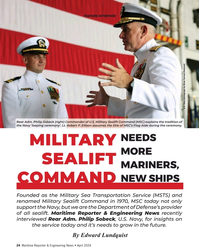 )
April 2024 - Maritime Reporter and Engineering News page: 24
)
April 2024 - Maritime Reporter and Engineering News page: 24FEATURE INTERVIEW U.S. Navy photograph by Brian Suriani/Released Rear Adm. Philip Sobeck (right) Commander of U.S. Military Sealift Command (MSC) explains the tradition of the Navy ‘looping ceremony’. Lt. Robert P. Ellison assumes the title of MSC’s Flag Aide during the ceremony. NEEDS MILITARY MORE
-
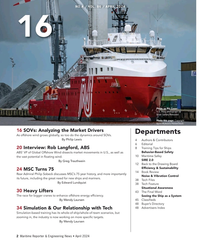 )
April 2024 - Maritime Reporter and Engineering News page: 2
)
April 2024 - Maritime Reporter and Engineering News page: 2NO.4 / VOL. 86 / APRIL 2024 16 Photo on the Cover: U.S. Navy photograph by Brian Suriani/Released Photo this page: Copyright Björn Wylezich/AdobeStock 16 SOVs: Analyzing the Market Drivers Departments As offshore wind grows globally, so too do the dynamics around SOVs. By Philip Lewis 4 Authors & Contribut
-
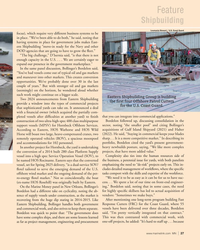 )
April 2024 - Marine News page: 27
)
April 2024 - Marine News page: 27Feature Shipbuilding Loumania Stewart / U.S. Coast Guard focus), which require very different business systems to be in place. “We’ve been able to do both,” he said, noting that having systems in place for government jobs makes East- ern Shipbuilding “move-in ready for the Navy and other DOD agencies
-
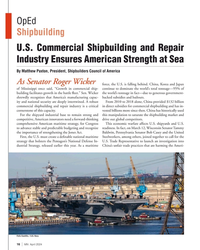 )
April 2024 - Marine News page: 16
)
April 2024 - Marine News page: 16OpEd Shipbuilding U.S. Commercial Shipbuilding and Repair Industry Ensures American Strength at Sea By Matthew Paxton, President, Shipbuilders Council of America As Senator Roger Wicker force, the U.S. is falling behind. China, Korea and Japan of Mississippi once said, “Growth in commercial ship-
-
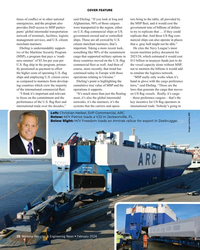 )
February 2024 - Maritime Reporter and Engineering News page: 28
)
February 2024 - Maritime Reporter and Engineering News page: 28COVER FEATURE times of con? ict or in other national said Ebeling. “If you look at Iraq and tors bring to the table, all provided by emergencies, and the program also Afghanistan, 98% of those cargoes the MSP ? eet, and it would cost the provides DoD access to MSP partici- were transported to the
-
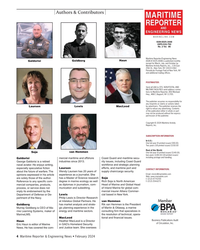 )
February 2024 - Maritime Reporter and Engineering News page: 4
)
February 2024 - Maritime Reporter and Engineering News page: 4Authors & Contributors MARITIME REPORTER AND ENGINEERING NEWS M A R I N E L I N K . C O M ISSN-0025-3448 USPS-016-750 No. 2 Vol. 86 Maritime Reporter/Engineering News Goldberg Haun (ISSN # 0025-3448) is published monthly Galdorisi except for March, July, and October by Maritime Activity Reports, Inc.
-
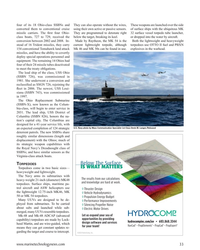 )
January 2024 - Marine Technology Reporter page: 33
)
January 2024 - Marine Technology Reporter page: 33four of its 18 Ohio-class SSBNs and They can also operate without the wires, These weapons are launched over the side converted them to conventional cruise using their own active or passive sensors. of surface ships with the ubiquitous MK missile carriers. The ? rst four Ohio- They are programmed to
-
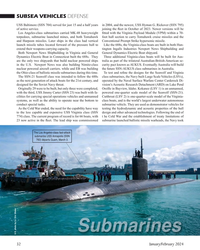 )
January 2024 - Marine Technology Reporter page: 32
)
January 2024 - Marine Technology Reporter page: 32SUBSEA VEHICLES DEFENSE USS Baltimore (SSN 704) served for just 15 and a half years in 2004, and the newest, USS Hyman G. Rickover (SSN 795) of active service. joining the ? eet in October of 2023. Newer versions will be Los Angeles-class submarines carried MK-48 heavyweight ? tted with the Virginia
-
 )
January 2024 - Marine Technology Reporter page: 31
)
January 2024 - Marine Technology Reporter page: 31at depths up to 1,000 feet. serve as a moored training ship (MTS ton. Some of the 688s were pulled from Hammerhead consists of a mooring 701) and the Nuclear Power School service at their mid-life point rather than module that plants itself on the bot- in Charleson, S.C. Likewise USS San incur the
-
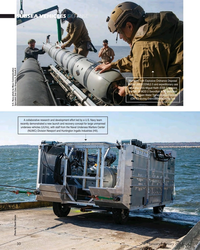 )
January 2024 - Marine Technology Reporter page: 30
)
January 2024 - Marine Technology Reporter page: 30SUBSEA VEHICLES DEFENSE Members from Explosive Ordnance Disposal Mobile Unit (EODMU) 5 and expeditionary sea base ship USS Miguel Keith (ESB 5) prepare the MK 18 MOD 2 Sword? sh to be deployed from the Open Water Transportation System (OWTS) during Exercise Noble Vanguard. U.S. Navy photo by Mass
-
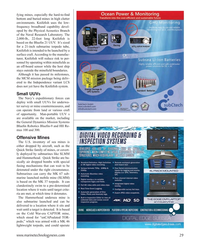 )
January 2024 - Marine Technology Reporter page: 29
)
January 2024 - Marine Technology Reporter page: 29fying mines, especially the hard-to-? nd bottom and buried mines in high clutter environments. Knife? sh uses the low- frequency broadband capability devel- oped by the Physical Acoustics Branch of the Naval Research Laboratory. The 2,000-lb., 22-foot long Knife? sh is based on the Blue? n 21 UUV.
-
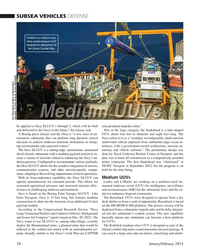 )
January 2024 - Marine Technology Reporter page: 28
)
January 2024 - Marine Technology Reporter page: 28SUBSEA VEHICLES DEFENSE Knife? sh is a medium-class mine countermeasure UUV designed for deployment off the Littoral Combat Ship. U.S. Navy photo by Mass Communication Specialist 1st Class Brian M. Brooks/RELEASED be applied to Orca XLUUV 1 through 5, which will be built (encapsulated torpedo) mine.
-
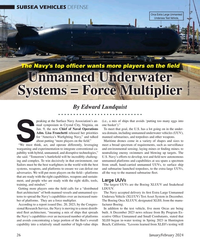 )
January 2024 - Marine Technology Reporter page: 26
)
January 2024 - Marine Technology Reporter page: 26SUBSEA VEHICLES DEFENSE Orca Extra Large Unmanned Undersea Test Vehicle. The Navy’s top of? cer wants more players on the ? eld Unmanned Underwater Systems = Force Multiplier Source: Boeing By Edward Lundquist peaking at the Surface Navy Association’s an- (i.e., a mix of ships that avoids ‘putting too
-
 )
January 2024 - Marine Technology Reporter page: 25
)
January 2024 - Marine Technology Reporter page: 25“The sky’s the limit in terms of payloads that can be brought into the vehicle.” Ann Stevens, Vice President, Boeing Maritime & Intelligence Systems subsea vehicles, speci? cally vehicles with increased endurance nautical miles. “You can go for months at a time without requir- to allow them to be deployed
-
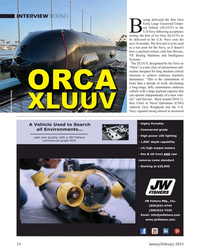 )
January 2024 - Marine Technology Reporter page: 24
)
January 2024 - Marine Technology Reporter page: 24INTERVIEW BOEING oeing delivered the ? rst Orca Extra Large Uncrewed Under- sea Vehicle (XLUUV) to the BU.S Navy following acceptance testing, the ? rst of six Orca XLUUVs to be delivered to the U.S. Navy over the next 18 months. The ? rst unit is to be used as a test asset for the Navy, so it
-
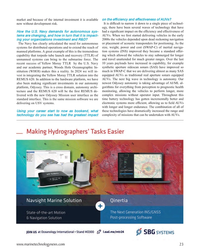 )
January 2024 - Marine Technology Reporter page: 23
)
January 2024 - Marine Technology Reporter page: 23market and because of the internal investment it is available on the ef? ciency and effectiveness of AUVs? now without development risk. It is dif? cult to narrow it down to a single piece of technol- ogy, there have been several waves of technology that have How the U.S. Navy demands for autonomous
